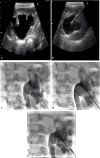Percutaneous nephrostomy in infants: a 20-year single-center experience
- PMID: 37593945
- PMCID: PMC11590733
- DOI: 10.4274/dir.2023.232276
Percutaneous nephrostomy in infants: a 20-year single-center experience
Abstract
Purpose: To investigate the safety and efficacy of the imaging-guided percutaneous nephrostomy (PCN) procedure in infants.
Methods: A total of 75 (50 boys; 66.7%) patients with a mean age of 121 days (range, 1-351 days) who underwent PCN over a period of 20 years were included in this retrospective study. For each patient, PCN indications, catheter size, the mean duration of catheterization, complications, and the procedure performed following nephrostomy were recorded. Technical success was determined based on the successful placement of the nephrostomy catheter within the pelvicalyceal system. Clinical success was defined as the complete resolution of hydronephrosis and improvement in renal function tests during follow-up. In patients with urinary leakage, technical and clinical success was determined based on the resolution of leakage.
Results: The technical success rate was 100%, and no procedure-related mortality was observed. In 11 patients (14.7%), bilateral PCN was performed. The most frequent indication of PCN was ureteropelvic junction obstruction (n = 41, 54.7%). Procedure-related major complications were encountered in two patients (methemoglobinemia and respiratory arrest caused by the local anesthetic agent in one patient and the development of urinoma caused by urinary leakage from the puncture site in the other). Mild urinary leakage was the only minor complication that occurred and only in one patient. Catheter-related complications were managed through replacement or revision surgery in 16 patients (21.3%).
Conclusion: Imaging-guided PCN is a feasible and effective procedure with high technical success and low major complication rates, and it is useful for protecting kidney function in infants.
Keywords: Percutaneous nephrostomy; complications; infants; interventional radiology; urinary tract obstruction.
Conflict of interest statement
The authors declared no conflicts of interest.
Figures


References
-
- Trambert JJ. Percutaneous nephrostomy placement in neonates: not simply “miniature adults”. Cardiovasc Intervent Radiol. 2020;43(9):1329–1330. - PubMed
-
- Koral K, Saker MC, Morello FP, Rigsby CK, Donaldson JS. Conventional versus modified technique for percutaneous nephrostomy in newborns and young infants. J Vasc Interv Radiol. 2003;14(1):113–116. - PubMed
MeSH terms
LinkOut - more resources
Full Text Sources

